
Guests
- Leslie Redmondeyewitness to Monday evening’s shooting in Minneapolis, Minnesota. She is a student at the University of St. Thomas School of Law and president of the Black Law Student Association.
Nearly 1,000 Black Lives Matter protesters took to the streets of Minneapolis, Minnesota, Tuesday after alleged white supremacists opened fire on a demonstration the night before, injuring five people. Police have now arrested three people in connection with the mass shooting, which took place at a protest outside a police precinct. At least one of the gunmen was reportedly wearing a mask. All three suspects are white. Authorities may treat the shooting as a hate crime. Witnesses of the shooting say police took an unusually long time to respond to the attack and then proceeded to use mace on the protesters. At the time of Monday’s attack, the Black Lives Matter protesters were gathered at an encampment outside a police precinct to protest the police killing of unarmed 24-year-old African American, Jamar Clark, which the Justice Department is now investigating. Authorities say Clark was shot in the head Sunday after a scuffle with officers who responded to a report of an assault. But multiple witnesses say Clark was shot while handcuffed. We speak with an eyewitness to Monday evening’s shooting, Leslie Redmond, who is a student at the University of St. Thomas School of Law and president of the Black Law Student Association.
Transcript
JUAN GONZÁLEZ: We turn now to Minneapolis, Minnesota, where nearly a thousand Black Lives Matter protesters took to the streets last night after alleged white supremacists opened fire on a demonstration the night before, injuring five people. Police have now arrested three men in connection with the mass shooting, which took place at a protest outside a police precinct. At least one of the gunmen was reportedly wearing a mask. All three suspects are white. Authorities may treat the shooting as a hate crime. Witnesses of the shooting say police took an unusually long time to respond to the attack—and then proceeded to use mace on the protesters. When activists reclaimed the streets Tuesday, they vowed not to be silenced by what some call an act of domestic terrorism. This is organizer Miski Noor.
MISKI NOOR: Despite earlier statements from police about the impending threat from white supremacists, the police instead maced citizen journalists and peaceful protesters. They made disparaging comments to those at the protest, instead of taking the threat seriously. We reiterate that we have zero faith in this police department’s desire to keep our community safe. We reiterate that we have zero faith in this police department’s desire to keep our community safe.
AMY GOODMAN: At the time of Monday evening’s attack, the Black Lives Matter protesters were gathered at an encampment outside a police precinct to protest the police killing of unarmed 24-year-old African American, Jamar Clark. The Justice Department is now investigating. Protesters were calling for the release of the video of that police killing. Authorities said Clark was shot in the head Sunday after a scuffle with officers who responded to a report of an assault. But multiple witnesses say Clark was shot while handcuffed. Minneapolis police officers Mark Ringgenberg and Dustin Schwarze have been placed on administrative leave during the investigation. Protesters have been camped outside the 4th Precinct since last week, despite a police raid last Wednesday in which multiple people said the police beat them with batons, sprayed them with mace and hit them with marker rounds.
Well, for more, we’re going to Minneapolis to speak with an eyewitness to Monday evening’s shooting, and then we’ll be speaking with Congressmember Ellison. Leslie Redmond is a student at University of St. Thomas School of Law and president of the Black Law Student Association.
We welcome you to Democracy Now! Can you start off by saying what happened two nights ago?
LESLIE REDMOND: Yes. Thank you for having me. So, basically, two nights ago, I came out. Everything was fine. People were socializing, eating, just communing as normal. And then a police officer comes and pokes his head over the precinct walls. This was a night unlike any other night. I’ve been out since Sunday every night consistently. This officer had on a ski mask, a ski mask very similar to the gunmen. He poked his head around. He, like, looked at the scene, saw what was going on. Less than 30 minutes after this officer with the ski mask that was poking his head over the precinct, these gunmen show up, who at the time, you know, we didn’t know who they were. They had on ski masks. They came up. We don’t allow people to have on ski masks anymore, because of the threats that we’ve been getting. Numerous Black Lives Matter representatives and NAACP heads have received death threats. So we’ve just been taking precautions when it comes to who is coming to the precinct.
A number of African-American males went over to the guys and basically asked them, like, “What are you here for? If you’re going to be here, you have to take off your masks.” The gunmen were not cooperative, and so the African-American males proceeded to walk them away. Mind you, these are our heroes, because there was a child that was three years old, another child that was eight years old, right beside me. We were less than 25 feet away from the gunmen. Who would have known what they would have done? They could have opened up fire on all of us. And these heroes—I call them heroes, the gentlemen that got shot, the people that got maced, the people that walked them away down the street. But it almost seemed like it was like a plot, or they were luring them down the street away, so then the police officers could say that they didn’t see anything, when, in actuality, they heard the shots just like I heard the shots.
There were over 10 shots fired. The police officers didn’t do anything. It seemed like they could have been in cahoots. They didn’t do anything when they came over the precinct. They just looked. I told someone to move the three-year-old and the eight-year-old child back towards the wall. And then I was on the phone with Jason Sole, who’s the head of the NAACP criminal justice committee, and I was telling him what happened, and he wanted me to confirm, you know, did someone actually get shot. And so, I really wanted to confirm, myself, but I was also extremely nervous, because I didn’t know if the gunmen were still there shooting.
Nevertheless, I was courageous, and I went, and I saw one person wounded, shot in their leg, another person wounded on the ground with a gun wound to the stomach. Everyone was going crazy trying to figure out what was going on. At the time, I didn’t realize that there were three other people who had been wounded, but they had transportation coming to get them, because, like I said, at this point it’s like 15 minutes that’s passed. No police officers have come out, no ambulance has come, no anything. Mind you, we’re right down the street from the precinct. I’ve seen the police officers. They were just peeking their head over the precinct doors with a ski mask on, so we could not see their face.
So then I went back, moved the kids towards the precinct building. And then I told them to take them to the car, because the police officers are just standing there doing nothing. I felt like we were really in danger, as if it was a war going on in our own backyard. So they took the kids to the car. I heard one of the police officers over say, you know, “They’re taking the kids to the car.” Like, they know what’s going on, and they have no intention to help us, stop it, do anything.
So, some police cars started to come up. I was looking. Like 20 police officers with their guns went running into the crowd. You would think they would run and actually help the witnesses, but instead they started to mace the witnesses, they started to push them back. They did not ask for any witness, any eye testimonies, no anything, until long after, maybe an hour after everything had transpired. The way that they treated the peaceful protesters and the way that they didn’t come and help—and even yesterday, I was at the hospital with one of the guys that got shot, Cameron Clark, all night, and he said like they just left him there, basically for dead. Like they were just waiting to leave. And it hurts you, you know? When you’ve stood up for what you believe in and stood up for justice and also tried to protect people, and the thanks that you get is the police basically tell you, “This is what you asked for”?
JUAN GONZÁLEZ: I wanted to ask you, Leslie Redmond, when you say that the gunmen, and you had a group of people try to escort them out, were they brandishing the guns, or did you later find out, when the shooting started, that they were armed?
LESLIE REDMOND: Oh, correct. So I later found out that they were gunmen. At the time, all we knew is that they had on ski masks. They had like a bag in their hand. They had a couple of signs in their hands. I don’t know what they had in the bag. Again, we have no idea what they had planned, if those individuals, those heroes, didn’t walk them away from the scene.
AMY GOODMAN: I want to turn to a video where masked men are seen driving to the Jamar Clark protest site and brandishing a pistol while making racist comments. The men in the video identify themselves by the aliases SaigaMarine and BlackPowderRanger. It’s still unclear if they were connected to Monday evening’s shooting. This is an excerpt of the video.
SAIGAMARINE: And yes, we are locked—we are locked and loaded.
BLACKPOWDERRANGER: You have a gun?
SAIGAMARINE: Why do you hate freedom?
BLACKPOWDERRANGER: Because. I don’t know.
SAIGAMARINE: All right, check it out, you guys. We’re going to be driving down there. It’s going to take us about 10 minutes to get down there. We’re going to take a little while and shut the camera off in a little bit. We just wanted to give everyone a head’s up on poll. We’re on our way. We’re going to knock this [bleep] out, and we’re going to go see what these dindus are dinduing about, you know, because apparently fighting police and fighting paramedics is good enough to let you off with a slap on the wrist, especially when you go for an officer’s weapon. So, yeah, a little reverse cultural enriching. We’re going to make the fire rise.
AMY GOODMAN: Now these men are wearing masks. They are spotted later at the Justice for Jamar Clark protest Thursday. In an activist-shot video, the men seem to respond sarcastically to questions regarding police brutality. This is an excerpt, beginning with the activists asking BlackPowderRanger a question.
ACTIVIST: The situation of Jamar Clark is the impetus of why you’re here.
BLACKPOWDERRANGER: Yes.
ACTIVIST: What does it look like for you, for the community? What do think it means to find justice for Jamar Clark?
BLACKPOWDERRANGER: Well, what I think it means is that all these folks here should get the justice and peace that they deserve. What we really need to do is reach out to our communities, especially our melanin-enriched communities.
AMY GOODMAN: And now I want to turn to the communications chair of the Mineapolis NAACP, Reisha Williams, speaking to CNN host Brooke Baldwin. Williams suggests members of law enforcement were behind the Monday night shooting of Black Lives Matter protesters.
REISHA WILLIAMS: We know that the police department is behind this. This is our personal belief, after receiving witnesses’ accounts, me personally being on the ground. Bob Kroll, Minneapolis department union head, has thrown [inaudible] out there—
BROOKE BALDWIN: Wait, wait, wait, wait. Forgive me. I have to interrupt you. I know there’s a delay here in Paris, but you said you believe the police department is behind what?
REISHA WILLIAMS: We believe the police department is facilitating the injustice at bullying to the protesters, and we also believe that they are involved in this shooting. We know from blackboards and from chat rooms and also videos that we have posted on our website, that police that are from different counties, police from different districts, have come down to entice the protesters, have come down to bully the protesters.
BROOKE BALDWIN: Those are—I understand you are there in Minneapolis, and you know much more about this, but those are serious allegations you are just laying down on national television.
REISHA WILLIAMS: Yeah, and we are standing behind it. We do not back down from these allegations.
AMY GOODMAN: That’s Reisha Williams of the NAACP in Minneapolis. Leslie Redmond, do you share her view? Now, three people have been arrested, three of these men.
LESLIE REDMOND: Right. Well, you know, the police came swarming in from the same areas that the gunmen fled into. Like I said, they took their precious time. So, I do agree with her. And I would also like to say, you know, I didn’t grow up in a household where I was scared of the police. I know that’s a lot of the African Americans in America lifestyle and basically their experience. But I grew up in Washington, D.C. I had uncles that were police officers, cousins that were police officers. I really looked at these people to protect and serve. But what I’ve been seeing over the past week, I wouldn’t put anything past the police officers.
I was out there when they were macing us, when they were shooting us with rubber bullets, when they were throwing tear gas at us—for no reason. Literally, we were peaceful. Do not believe what the media feeds you. No one was doing anything to those officers. And then, when I was actually on the ground and I saw those police officers come over the precinct for the first time with the ski masks on, they looked exactly like the people that ended up being the gunmen. It’s like, how do you not make the correlation? And then, when they didn’t come to help these men, it seemed like they were in cahoots.
I cannot say for sure I know that they did it, but the belief is definitely there. And the people that were there, we definitely feel like the police could have definitely had something to do with it. In addition, the gentlemen who all got shot were the same ones who were like in the front lines of the protests, out there every day fussing with the police officers, telling them that they were doing an injustice. So, I just don’t think that those are all coincidences.
JUAN GONZÁLEZ: Well, Leslie Redmond, one last question.
LESLIE REDMOND: Sure.
JUAN GONZÁLEZ: You visited one of the people in the hospital. How are the people who were wounded doing? And one of them was the cousin of Jamar Clark, the man whom you were—whose death you were protesting?
LESLIE REDMOND: Yes. So, Cameron Clark, he is the cousin. I actually went to the hospital about 2:00 a.m., and I stayed until probably 5:30 p.m., until he was released, because we did not want to leave him there by himself, just because of all of the shady things that have been going on. Cameron is in really good spirits. He was shot twice—one in the leg, one in the foot. He actually went to the protest yesterday evening, against my better judgment. I told him that he should go get some rest. But he really is passionate about this. He really didn’t want to leave his brothers and sisters out there. He didn’t want these gunmen and the police to think that they won, because we think that this was a plot to try to get us to go away. But we want them to know we’re only coming out stronger, because we’re standing on the side of justice. We’re standing on the right side of history. And these people that were shot are heroes of society. The other individuals that have gotten shot, they had to go into surgery, and they’re still hospitalized, from my understanding. But Cameron was released. I was there when he was released. I stayed with him the entire time.
AMY GOODMAN: Leslie Redmond, we want to thank you so much for being with us—
LESLIE REDMOND: Thank you.
AMY GOODMAN: —eyewitness to Monday evening’s shooting in Minneapolis, Minnesota, Black Lives Matter protester, student at the University of St. Thomas School of Law, president of the Black Law Student Association. We’re going to go to break, and we’ll come right back to speak with Minneapolis Congressmember Keith Ellison. His son was at the protests of the killing of Jamar Clark by police, and now a picture has gone viral of police with a gun pointed directly at Jeremiah. Stay with us.


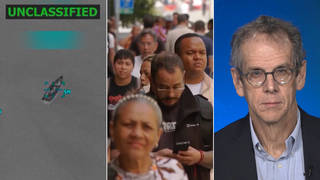
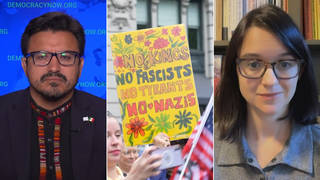
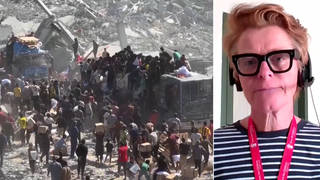





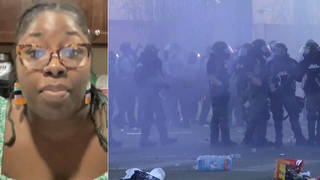
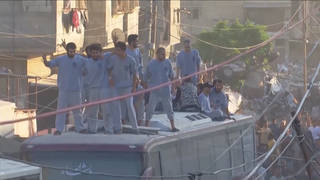
Media Options